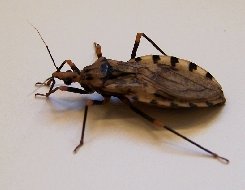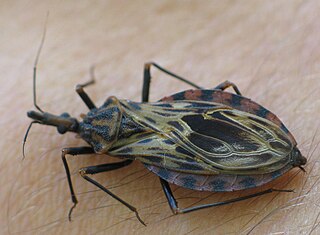
Triatoma protracta is a species of bugs in the family Reduviidae. It is known commonly as the western bloodsucking conenose. It is distributed in the western United States and Mexico.

The members of the Triatominae, a subfamily of the Reduviidae, are also known as conenose bugs, kissing bugs, or vampire bugs. Other local names for them used in The Americas include barbeiros, vinchucas, pitos, chipos and chinches. Most of the 130 or more species of this subfamily feed on vertebrate blood; a very few species feed on invertebrates. They are mainly found and widespread in the Americas, with a few species present in Asia and Africa. These bugs usually share shelter with nesting vertebrates, from which they suck blood. In areas where Chagas disease occurs, all triatomine species are potential vectors of the Chagas disease parasite Trypanosoma cruzi, but only those species that are well adapted to living with humans are considered important vectors. Also, proteins released from their bites have been known to induce anaphylaxis in sensitive and sensitized individuals.

Triatoma infestans, commonly called winchuka or vinchuca in Argentina, Bolivia, Uruguay and Chile, barbeiro in Brazil, chipo in Venezuela and also known as "kissing bug" or "barber bug" in English, is a blood-sucking bug and the most important vector of Trypanosoma cruzi which can lead to Chagas disease. It is widespread in the Southern Cone countries of South America. This region has joined the control intervention called Southern Cone Initiative managed by the PAHO.

Triatoma is a genus of assassin bug in the subfamily Triatominae. The members of Triatoma are blood-sucking insects that can transmit serious diseases, such as Chagas disease. Their saliva may also trigger allergic reactions in sensitive individuals, up to and including severe anaphylactic shock.

Rhodnius is a genus of assassin bugs in the subfamily Triatominae, and is an important vector in the spread of Chagas disease. The Rhodnius species were important models for Sir Vincent Wigglesworth's studies of insect physiology, specifically growth and development.

Panstrogylus geniculatus is a blood-sucking sylvatic insect noted as a putative vector of minor importance in the transmission of Trypanosoma cruzi to humans; this is a parasite, which causes Chagas disease. The insect is described as sylvatic; subsisting primarily in humid forests, and is also known to inhabit vertebrate nesting places such as those of the armadillo, and is also involved in enzootic transmission of T. cruzi to those species. It has wide distribution throughout 16 Latin American countries.

Triatoma dimidiata is a blood-sucking insect whose range extends from northern South America, throughout all the countries of Central America and into Southern Mexico. It is among the most important carriers of Trypanosoma cruzi, the flagellate protozoa that causes Chagas disease. Dimidiata has been found in rock piles, caves occupied by bats, hollow trees occupied by mammals or birds, and other diverse ecotopes. However, their presence in human abodes is usually happenstance; people tend to bring them indoors with their firewood. When in the nymph form they may camouflage themselves from predators by scraping dust over their dorsal abdomen, a behavior also observed in T. phyllosoma, T. nigromaculata, Panstrongylus geniculatus, P. megistus and P. herreri nymphs. Moreover, due to geological past in Mesoamerica such as forest loss, and rising temperatures, there has been an increase in Triatomine bugs infestation.

Trypanosoma cruzi is a species of parasitic euglenoids. Among the protozoa, the trypanosomes characteristically bore tissue in another organism and feed on blood (primarily) and also lymph. This behaviour causes disease or the likelihood of disease that varies with the organism: Chagas disease in humans, dourine and surra in horses, and a brucellosis-like disease in cattle. Parasites need a host body and the haematophagous insect triatomine is the major vector in accord with a mechanism of infection. The triatomine likes the nests of vertebrate animals for shelter, where it bites and sucks blood for food. Individual triatomines infected with protozoa from other contact with animals transmit trypanosomes when the triatomine deposits its faeces on the host's skin surface and then bites. Penetration of the infected faeces is further facilitated by the scratching of the bite area by the human or animal host.

Triatoma nigromaculata is a sylvatic species of insect usually found in hollow trees, in vertebrate nests on trees and occasionally in human dwellings. It usually lives in relatively humid forests at high altitudes on mountain regions and foot hills. As all members of the subfamily Triatominae, T. nigromaculata is a blood-sucking bug and a potential vector of Chagas disease. This species is distributed mainly in Venezuela, but some specimens have also been found in Perú and Colombia (Cauca).

Triatoma brasiliensis is now considered the most important Chagas disease vector in the semiarid areas of northeastern Brazil. T. brasiliensis occurs in 12 Brazilian states, including Maranhão, Piauí, Ceará, Rio Grande do Norte, and Paraíba.

Triatoma rubrovaria is an insect which is ubiquitous in Uruguay, in neighboring parts of northeastern Argentina, and in the southern states of Paraná and Rio Grande do Sul in Brazil. This species of triatomine is found mainly among exfoliate rocks known as pedregales. It was earlier reported as T. (triatoma) rubrovaria, a sylvatic species inhabiting rock piles, rarely found in human dwellings. This species may be a highly competent vector of Trypanosoma cruzi, the causative agent of Chagas disease. In Rio Grande do Sul, data from the Chagas disease Control Program have indicated an increasing of domiciliary and peridomiciliary invasion of T. rubrovaria, where it has become the most frequently triatomine species captured in that State since the control of T. infestans.
Trypanosoma rangeli is a species of hemoflagellate excavate parasites of the genus Trypanosoma. Although infecting a variety of mammalian species in a wide geographical area in Central and South America, this parasite is considered non-pathogenic to these hosts. T. rangeli is transmitted by bite of infected triatomine bugs of the Reduviidae family, commonly known as barbeiro, winchuka(vinchuca), chinche, pito ou chupão.

Triatoma dominicana is an extinct species of assassin bug in the subfamily Triatominae, the kissing bugs known from early Miocene Burdigalian stage Dominican amber deposits on the island of Hispaniola.

Trypanosoma antiquus is an extinct species of kinetoplastid, a monophyletic group of unicellular parasitic flagellate protozoa.

Triatoma sanguisuga, also known as the Eastern Bloodsucking Conenose or the Mexican Bed Bug, is an insect of the Triatominae subfamily, known as kissing bugs. It is found throughout North America and Latin America, and is common in the Southeastern United States. They are generally 16 to 21 mm long, black or dark brown, with six reddish-orange spots along each side of a wide abdomen. They are winged, have kinked, six-segmented antennae, and have a slender, tapered proboscis used for feeding.
Triatoma indictiva is an arthropod in the assassin bug family of Reduviidae, and is an important vector of Trypanosoma cruzi. T. cruzi is the protozoan that causes Chagas Disease, which affects approximately eight million people a year in the western hemisphere alone. Triatoma indictiva is found in Mexico and throughout the southern United States, including Arizona and Texas.

Linshcosteus is a genus of assassin bugs in the subfamily Triatominae. It is the only genus of Triatomines restricted to the Old World within the mostly Neotropical subfamily Triatominae and consists of six species restricted to peninsular India. Within the Triatominae, the genus is differentiated by the lack of a prosternal stridulatory furrow and a short rostrum that does not reach the prosternum. Adults feed on vertebrate blood.

Panstrongylus megistus is a blood-drinking insect in the subfamily Triatominae. It is found in the Guianas, Brazil, Bolivia, Paraguay, Uruguay and Argentina, and is an important vector of Trypanosoma cruzi, particularly in Brazil. Besides humans, P. megistus is known to feed on birds, rodents, horses, dogs, opossums and bats.

Triatoma sordida is an assassin bug within the genus Triatoma. This species consists of three subspecies. Also referred to as kissing bugs, T.sordida are most well known for their role as a secondary vector of Chagas Disease. Inhabiting warm, dry climates, T.sordida are widely distributed throughout South America, occupying houses, farming structures, and wild habitats. Pest control is currently focused on insecticide application. However, biological controls utilizing fungi appear promising.

















